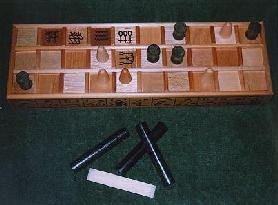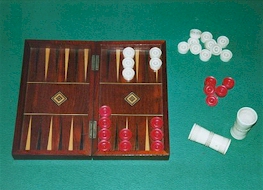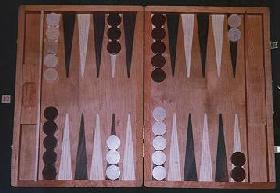
History Where to Buy Rules Links
 |
Gaming boards of 3 x 10 squares have been found extensively in ancient
Egyptian archaeological sites. The game was known to the ancient
Egyptians as the Game of Thirty Squares or Senet
(sometimes Senat). The exact rules are not known. Similar
boards have also been found consisting of 3 x 12 squares, 3 x 6 squares
and other patterns - it's not clear if these are different games or
mere variants. A number of boards have been found which feature
Senet on one side and another popular Egyptian game, the Game
of Twenty Squares, on the other.
The picture shows a modern commercial version of the game of Senet from the author's collection. |
Backgammon-type games have been played for thousands of years in all parts of the world and certainly during the Egyptian, Greek and Roman eras. The Romans left a great deal of evidence of a game they called Ludus Duodecim Scriptorum, the game of the twelve lines. The game is possibly derived from the Egyptian Senat having a topological set of 3 x 12 points and being played with 3 x 6 sided dice but, again, the rules have never been fully ascertained. In the first century AD, Ludus Duodecim Scriptorum seems to have been replaced by a variant with only 2 rows of 12 points, a game which by the 6th century was called 'Alea'. Both these games and others were also referred to as 'Tabula', which was a generic game for 'boardgame' and in early mediaeval times was usually used to mean the most popular boardgame, Ducodecim Scriptorum/Alea/Backgammon, in the same way that the generic term 'football' normally means 'soccer' in England today.
In Asia, the game of Nard appeared sometime prior to 800 AD, in South West Asia or in Persia depending upon which version of history one believes, and variants are played today throughout the continent. Chinese history gives that t'shu-p'u, the Chinese name for Nard was invented in Western India, arrived in China during the Wei dynasty (220 - 265 AD) and became popular from 479 to 1000AD. In Japan the game was called Sugoroko and was declared illegal during the reign of Empress Jito (690 - 697AD). Nard, in turn, seems to have been introduced into Europe via Italy or Spain following the Arab occupation of Sicily (902 AD).
The first mention of the game in English print was in The Codex Exoniensis published in 1025: "These two shall sit at Tables...". Tables was probably brought to England by men returning from the Crusades. Nard or Tables was played throughout Europe during the middle ages and became very popular in English Taverns, although Chess overtook it as the more popular game in the fifteenth century. By the end of the sixteenth century, Tables had, for some reason, become a generic term for any game played on a flat surface or table. Like many games played for money, it became unpopular with the authorities in England and, until the reign of Elizabeth I, laws prohibiting the playing of Tables in licensed establishments were in force. In the early seventeenth century, however, following some modifications to the rules, the game underwent a revival and it swept across Europe again under a variety of different names which have mostly stayed the same until today:

Image is of a board from the author's parents collection. |
England - Backgammon Scotland - Gammon France - Tric-Trac Germany - Puff Spain - Tablas Reales Italy - Tavole Reale Czech - Vrhcßby |

Image is of a board from the author's collection |
It is a subject of debate as to whether the term Backgammon is derived from the Welsh 'back' (little) and 'gammon' (battle) or from the Saxon 'bac' (back) 'gamen' (game).
Backgammon underwent another revival before the first World War but waned during the middle of the twentieth century only to recover again in the 1970s to become the popular game it is today. It is still widely played in the Middle East as Tric-trac.
There are a whole family of variants: Chouette (3 or 4 player version), Partnership backgammon, Sixey-Acey, Dutch Backgammon, Turkish Backgammon (Moultezim), Greek Backgammon (Plakato), Gioul (from the Middle East), Acey Deucey (US Forces version of Dutch Backgammon), European Acey Deucey, Russian Backgammon, Tabard Backgammon and Icelandic Backgammon (Kotra).
You can buy an wooden inlaid Backgammon set from Masters Games.
Masters Games also supplies free game rules for traditional games.
Markus Kantz has a detailed page on Senet. The Translator website might help you to understand some of it if you don't speak German.
Chicago Point Backgammon On-line - An excellent links page from Mel Leifer
GammonVillage - An interesting Internet Backgammon magazine
A Japanese translation of this page.
![]()
| The Online Guide to Traditional Games Home | Copyright ® 1997-2001 by AGames. |